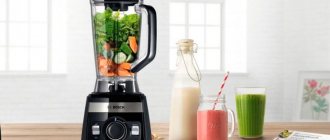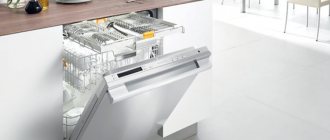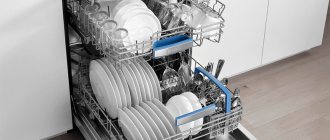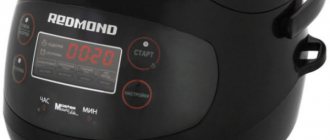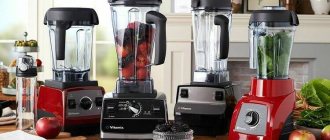Description of species
The blender bowl is usually called the working container into which the processed product is placed and the main operation is carried out.
In stationary devices, it is considered a mandatory structural element, and the corresponding nozzle is fixed inside it. The set of immersion blenders usually also includes various containers, but they can be replaced with any other container, because... they are not connected to the working body.
A blender may have only one bowl, but modern models are often equipped with several types of containers.
The following types of blender bowls are available:
- Jug . This is the most common type of working, removable container for mixing, beating and chopping not too hard products. It can be given an elongated shape or a bowl-shaped shape with a widened top. Usually the jug is closed with a splash-proof lid or filter mesh. The cup is well suited for kneading dough and making cream. A possible option is a mug for small portions of kneading or beating (for example, an egg)
- Mill , coffee grinder . Essentially, it is a jug with knives at the bottom. Such a grinder is usually required when grinding hard, dry products. A high, metal lid is installed on top.
- Chopper . It is a flask-shaped grinder with a metal lid. Such a bowl is equipped with very sharp and powerful knives that chop any mixture in an accelerated mode. Can process products with liquid consistency.
- Glass for cocktails and smoothies . This is a tall, transparent glass in which you can prepare a portioned drink.
- A travel “bottle” is a small container that you can take with you on the road.
There are models of blenders that have 2 bowls. They make it possible to prepare 2 different drinks (dishes) at the same time.
About
Review of the Redmond RHB-2989 blender with the functions of chopping, whipping, slicing, shredding and more
Immersion blenders with a large number of accessories are not very frequent guests in the iXBT laboratory. However, sometimes similar devices come to us for review, and we get the opportunity to compare them with each other.
The Redmond RHB-2989 blender initially seemed vaguely familiar to us: we had already reviewed a similar device with almost identical technical characteristics and a similar set of accessories - it was the Garlyn HB-320 immersion blender. The similarity is especially striking when visually comparing some attachments. However, the difference in price is significant: the Redmond model at the time of publication of the review cost from 6.5 thousand rubles, and the Garlyn model - from 11 thousand.
Also among similar devices, we can recall the Redmond RHB-CB2978 blender, which has slightly higher power, but is equipped with fewer attachments.
In general, let's take a look at the new device and understand how beneficial such an offer will be in terms of price and quality ratio.
Characteristics
| Manufacturer | Redmond |
| Model | RHB-2989 |
| Type | immersion blender |
| Country of Origin | China |
| Guarantee | 12 months |
| Life time* | 3 years |
| Maximum power | 1300 W |
| overheat protection | There is |
| Overload protection | There is |
| Protection against electric shock | class II |
| Smooth speed control | There is |
| Speed in main mode | 9000—15000 rpm |
| Turbo mode | yes, 16000 rpm |
| Additional attachments | immersion blender, whisk, mixer, grater/shredder, dicing attachment, puree attachment, small chopper blade, large chopper blade |
| Chopper bowl volume | 500 ml |
| Mixing glass volume | 600 ml |
| Combine bowl volume | 2000 ml |
| Weight | 3.1 kg |
| Dimensions (W×H×D) | 66×390×66 mm |
| Network cable length | 1m |
| Retail offers | find out the price |
* Contrary to popular belief, this is not the time limit after which the device will necessarily break down. However, after this period, the manufacturer ceases to bear any responsibility for its performance and has the right to refuse to repair it, even for a fee.
Equipment
The almost cubic box, in typical Redmond style, is made of black cardboard with bright designs. On the edges and on the top flap of the box there is a picture of the blender itself, complete, and on the sides there is a photograph of a woman, drawing additional attention to the packaging. The side faces provide basic technical information, as well as a more detailed description of the device's capabilities. In particular, it is indicated here that the device is an “8 in 1” multi-system.
On the side you can also find colorful photographs of accessories and finished dishes prepared using our blender.
Opening the box, we found quite a lot inside. Here we found:
- electric motor block
- blender attachment
- whisk attachment
- S-shaped knife (for large and small bowls)
- milk frother
- pusher
- dicing attachment
- small chopper bowl with lid
- removable sleeve
- large chopper bowl with lid
- mixing glass with lid
- grate cleaning tool
- attachment for making potato pancakes
- manual
- service book
At first sight
A multifunctional blender consists of quite a large number of different elements, but it all starts, naturally, with the motor unit. It turned out to be quite weighty, the shape was traditional oblong. The main material of the motor block is white glossy plastic. The ring around the variable speed control knob is painted metal, the rubber pad protecting the buttons is made of gray rubber.
On the top of the motor block there is a speed shift scale from 1 to 5 through intermediate values indicated by dots. The arrow ring rotates smoothly, without sounds or clicks.
An electrical cord comes out under the ring at the back of the motor block. In this part of the device there is a slight narrowing, which is slightly more pronounced at the back - to make it comfortable to hold and press the buttons at the same time.
On the body of the device there is a logo, advertising stickers, and an inscription, according to which we can find out that the power of the device is 1300 W. Next to it are pictograms depicting hot soup, an unidentified dish and a cocktail. On the back there are stickers with technical information and the model serial number.
The attachments are fixed using two spring-loaded buttons that control a special plastic grip located inside the case. Installation of attachments is carried out automatically (the grip snaps into place during installation), but to remove the attachment you will have to press both buttons at the same time.
Let's now take a step-by-step look at all the attachments included with the device.
Attachments that fit onto the motor block
Two attachments are attached directly to the motor block - a classic attachment for chopping and a whisk for whipping.
The grinding attachment is made of stainless steel. On one side it has a plastic extension with a socket for attaching to the motor block, on the other there is a two-bladed knife of a complex shape on a thin rod. The knife is covered with a metal dome with cutouts and slits. The attachment looks quite standard; we have repeatedly seen such attachments on other models of immersion blenders.
The whisk is also made of stainless steel, but, unlike the chopper attachment, it is removable from the plastic base, so it can be easily cleaned or washed under running water. The working part of the nozzle is made of thin curved metal rods, which is also a kind of standard.
As a “bonus”, the manufacturer included in the kit a miniature cappuccino maker for frothing milk, which can be installed instead of the whisk attachment.
To work with an immersion blender and whisk, the kit includes a chopping glass made of transparent plastic with a bluish tint. It has a stable bottom due to its downward expansion without any anti-slip inserts, and a measuring scale from 100 to 600 ml is applied to the wall.
An additional accessory to the glass - a rubber lid - allows you to store the glass along with its contents in the refrigerator.
Bowls and attachments for them
The small bowl and the large one look very different. The small bowl is quite standard, such a bowl can be seen complete with 3-in-1 immersion blenders. The body of the small bowl is made of transparent plastic, with graduations on the sides - from 100 to 500 ml in 100 ml increments, and from 4 to 16 ounces in 4 oz increments.
The bowl is connected to the motor block using a standard plastic cover, in the center of which there is a device that transmits a rotational element to the knife. The lid closes by turning clockwise. The knife is ordinary, two-bladed, installed inside on a peg located in the center. There are anti-slip rubber pads at the bottom of the bowl. Everything looks neat and standard.
The lid of the large bowl is also made of white plastic and is equipped with two protrusions - a through pipe for feeding food and a socket for connecting the motor unit. The cross-section of the product supply pipe is a rectangle with strongly rounded corners. The lid is thick and massive, from the inside there is a sign of a crossed out faucet embossed on it: it cannot be washed under running water (the fact is that there is a gearbox inside).
The large bowl itself is made of transparent plastic and has a slightly tapering shape. It has a rubber ring at the bottom that prevents slipping. A measuring scale in ounces and milliliters (from 250 to 2000 ml) is applied to the wall of the bowl on both sides. In the middle of the bottom there is a peg for attaching attachments.
The bowl has a handle (again white plastic) with a plastic button. The button is used to fix the lid: the lid has a tongue and cutouts that must be aligned with the protrusions on the bowl. The tongue should be to the right of the bowl when looking at it from the handle. When the lid fits tightly on the bowl, you need to turn it clockwise so that the tongue fits into the groove on the lid handle until the button clicks. To remove the cover, you need to press the button and, without releasing it, turn the cover counterclockwise until it stops.
The large bowl has several attachments. Firstly, this is a large chopping knife for meat, chicken and other products. The knife looks like an enlarged copy of a small knife for a small bowl. The knife is installed and fixed in the same way.
Also included in the kit were two stainless steel discs. One of them is intended for grating/shredding, the second is for preparing potato pancakes. When working with discs, another rod is used (it is put on a peg in the bowl, and the desired disc is put on it with the working side up).
Finally, the dicing tool comes in the form of a thick black plastic disc with a rectangular lattice blade on the edge and a peg in the center. To install the disk, you need to place it in the bowl so that the grid-knife is opposite the handle of the bowl, after which a rotating knife is put on the peg (it cuts the food into slices). Cubes, in turn, are obtained when we manually push the product using a plastic pusher.
If necessary, the lattice knife can be removed along with the frame, but this must be done carefully: it is very easy to cut yourself here.
To clean the knife, there is a special plastic pusher attachment that follows the shape of the knife itself.
Instructions
A small brochure in a black cover in three languages (Russian, Ukrainian, Kazakh) talks about the design and control of the blender device. Most of the instructions are devoted to all sorts of diagrams and illustrations, which is not surprising: the process of assembling a device to solve certain problems is generally intuitive, but it can raise questions (especially if we are using such a device for the first time, and the abundance of attachments and accessories makes our eyes wide open).
The instructions also provide the technical data of the blender, its equipment and device (where is which socket, button, what is attached to what).
In the “Operation” section there is a useful sign, from which it is clear in what modes, for what purpose and for how long this model can operate. As an immersion blender, it can be used for no more than 2-3 minutes, and the break between approaches should be at least 5 minutes. The mixer and grinder can work continuously for even less: 30 seconds each with a break of 5 minutes. A food processor with attachments for dicing and grating/shredding operates for no more than 60 seconds with a break of 5 minutes. The same recommendations are given for working with metal grinding discs.
If the operating time is significantly exceeded, the overheating and overload protection system may operate. If the engine stops, you need to unplug the device and let it “rest” for at least half an hour.
The kit also includes a warranty book.
Control
Like all immersion blenders, the control of our device is entirely on the motor unit, which must be connected to all attachments and bowls for operation.
There are two buttons on the block: the top one turns on the main mode, and the bottom one turns on the turbo mode. The rubber protecting the buttons has corresponding icons printed (embossed), so you can literally find the buttons by touch.
Above the buttons there is a rotation speed control knob, which allows you to increase (or decrease) the speed smoothly. At the end of the motor block there is a scale from 1 to 5 with intermediate points, and on the ring there is an arrow that shows at what speed the device is currently operating.
There is no zero speed; to stop the device you need to use the on (off) button.
Exploitation
Before turning it on for the first time, according to the manufacturer’s advice, we washed all washable attachments and bowls with warm water and detergent, and wiped all other parts of the blender with a damp cloth.
When we first turned it on, we noted that the fairly weighty motor unit fit very comfortably in the hand. The normal and turbo mode buttons can be pressed without looking.
All connections and covers are held securely closed and click and release easily and simply. The main thing is to perform all operations with clean hands.
Also, do not forget that all knives and cutting edges are very sharp, and therefore they must be handled with extreme caution.
Care
Some parts of the blender are dishwasher safe. Unfortunately, not all of them. What gave us the most trouble with maintenance was the gearbox unit, which not only cannot be placed in the dishwasher, but is even prohibited from being washed under running water.
But it gets quite dirty! Drops of juice and product particles fall onto the lower part and into the loading area. It was especially difficult for us when cleaning colored products - beets and carrots. Obviously, if we are going to grind fatty foods, then there will be even more problems.
The bowls themselves and all attachments, except for the immersion blender attachment, can be washed in the dishwasher at a temperature not exceeding 60 °C and preferably not with powder, but with gel. Also, all bowls and attachments (including the blender attachment) can be washed under the tap with a mild detergent.
Hard scourers and brushes, as well as abrasive or caustic chemical cleaning agents, are prohibited.
To clean the grid knife, the kit includes a special pusher that can be used to squeeze out food stuck in the grid cells. It is easy and simple to use, but if hard food (such as carrots) is stuck in the grill, it may require some effort.
Finally, the last thing we noted is that the white plastic from which many parts of the device are made is easy to paint. We discovered that characteristic yellow spots appeared on it after the first chopping of raw carrots. The situation, in principle, is standard and predictable, and can also be easily solved with a drop of oil.
Our measurements
First of all, we decided to check the weight of those attachments that need to be held suspended: the motor unit, the immersion blender attachment, and the whisk attachment.
| Nozzle or combination | Weight, g |
| Motor block | 600 |
| Immersion nozzle | 122 |
| Whisk attachment with plastic module | 92 |
| Cappuccino maker with plastic module | 90 |
| Motor unit + submersible nozzle | 722 |
As we can see, the hand part of the blender is more or less weighty, but it lies confidently in the hand and does not cause any discomfort.
The energy consumption of the device depends on the attachments used and the products processed. The maximum power recorded during testing was 645 W and was achieved during intensive chopping of raw carrots.
When cutting food into cubes, the power reached 220 W, when chopping greens (in a small bowl) - up to 75 W, blending soup in a pan using a chopping attachment resulted in wattmeter readings of up to 135 W.
At rest, the motor unit consumes 0.4 W.
The noise level varied predictably depending on the task being performed, but overall we felt it was standard for devices in this category.
Practice tests
During the tests, we prepared several dishes using various attachments and accessories. Looking ahead, we will say that in most cases the result was assessed by us as good, but there were exceptions.
Grinding tomatoes
Chopping tomatoes is our standard test for blenders. With its help, we find out how well the device copes with such complex particles as skins and seeds.
For the dough, we took plum tomatoes, cut them into quarters, filled the glass about two-thirds full and started blending.
We crushed the tomatoes for one minute with a smooth increase in speed from 1 to 5. In the first 10-15 seconds, we had to shake the contents several times and apply a little force (press on the tomatoes), and then the grinding occurred with the device stationary.
We evaluate the result as standard for immersion blenders: the tomatoes turned into juice, among which there were noticeable scraps of skins.
An additional minute of grinding slightly reduced the number of skins and their size, but the overall situation remained the same - the particles were visible to the naked eye and clearly felt on the tongue.
The maximum power achieved by the blender was 110 W, and the average was about 90 W. Electricity costs turned out to be minimal: 0.001 kWh.
The blender grinds quickly and relatively well, but it is not suitable for obtaining a homogeneous substance.
Result: good
Omelet (work with a whisk)
The whisk attachment is ideal for preparing batters, as well as beating eggs and egg mixtures.
We decided to make the most ordinary omelet. Take eggs, milk, salt and beat for 60 seconds.
We were more than pleased with the result: the eggs and milk mixed well and slightly increased in volume, with a large number of bubbles visible on the surface of the glass.
The mixture went into the frying pan.
And then - onto the plate.
Result: excellent.
Salmon soup with cream
While preparing the soup, we tested two attachments at once - first we cut the ingredients into cubes, and then blended the soup using a standard blender attachment.
For cutting into cubes, we used raw carrots and raw potatoes. Our blender passed the test with flying colors. Once we got the hang of it and experimentally established with what force we needed to push the vegetables into the chopper, the process went smoothly and easily.
The cubes themselves seemed a little too big to us, but this, as they say, is a matter of taste. The main thing is not to press the ingredients too quickly so that the cubes do not turn into sticks. In the photo below (with a bow) this is exactly what happened.
But we chopped the carrots and potatoes generally evenly.
The only nuance that caught our attention was the rather large amount of waste that remains inside the cutting area after the cooking process is completed. We found large pieces of carrots next to the rotary cutter.
...and also inside the dicing grid.
This does not cause any big problems (the mesh can be easily cleaned using a special accessory), but you need to understand that the dicing attachment is unlikely to be suitable for chopping one or two potatoes.
Blending the finished soup went without incident. This is what it looked like before adding cream:
Then - with cream.
To appreciate the work that a blender has to do, let's take a look at what's at the bottom of the pan.
We started blending. The device confidently got to work, and the nozzle even “sucked” to the bottom.
Energy consumption was up to 220 W when cutting into cubes and up to 135 W when blending soup.
Final result: good, but not perfect. It was not possible to achieve a completely creamy mass; small particles were felt on the tongue, but we did not find any large unground pieces.
Result: good
Shredder
We decided to test the shredding disc on carrots. The raw carrots were peeled and sent to the shredder. Here the blender had to work hard: power consumption reached 645 W.
The result was close to ideal: all the carrots were easily chopped.
We found very little waste inside the slicing chamber.
Result: excellent.
Grinding (small bowl)
We placed a bunch of fresh herbs in a small bowl, connected the motor unit and began chopping. The wattmeter showed consumption up to 75 W.
The greens were chopped in a matter of seconds. All we had to do was open the lid once and stir the contents (so that the long stems stuck to the sides of the bowl would come under the knife).
Result: excellent.
Cutting into cubes (vinaigrette)
How will the device cope with chopping boiled vegetables? We found beets, potatoes and carrots.
We started grinding. First - potatoes.
Then - carrots. But we decided to cut the pickled cucumber by hand (it contains a lot of moisture).
Separately, chop the beets and add a little vegetable oil to it (so that it does not color the other ingredients too intensely)
The cutting went smoothly again; the large bowl was filled to the brim with vegetable cubes in just a minute. All that remains is to add green peas and sauerkraut.
Result: excellent.
Attachment for potato pancakes
But we had a failure with potato pancakes. And this despite the fact that cooking pancakes is one of the key functions declared by the manufacturer.
Just a couple of raw potatoes led to the engine unit overheating: I had to wait about 30 minutes until it cooled down and started working. The second overheating happened even faster.
The amount of waste (large potato particles) removed from the slicing chamber turned out to be quite large.
This is not at all the result that we expect from an attachment for making potato pancakes: we expected that we could quickly and easily chop a large volume of potatoes, but in practice it turned out to be easier to use a regular hand grater.
However, here is a photo of what grated potatoes look like. This option would appeal to lovers of classic Ukrainian and Belarusian recipes, but why overheat twice?
Result: bad.
conclusions
The RHB-2989 blender made an overall positive impression on us. The device turned out to be truly multifunctional, practically a food processor: it performed successfully in almost all tests, with the exception of using the attachment for preparing potato pancakes.
The disadvantage of our device is the potential difficulties in cleaning. The parts have many places where food particles can get in: the rotating knife, the grill knife, and the places where the lid joins the bowl... All this requires attention and time. Of course, in home use, we may not get carried away with perfectionism and not clean the device to perfect condition (it’s okay if a dried piece of carrot or potato remains here and there). However, if you need to clean the device “as expected,” then this process will not be very fast. The gearbox cover is especially difficult to clean, as it cannot be immersed under running water. You have to use paper napkins, rags, toothpicks and other improvised means.
Thus, using a device for chopping or dicing is advisable only in cases where you need to quickly prepare a large amount of product - for example, for the New Year or for any other feast. But using it to prepare a couple of servings of vinaigrette or salad is unlikely to be wise: caring for the device and cleaning it will take about the same amount of time as it would take to cut the ingredients by hand.
However, this is typical for all immersion blenders with a large number of attachments - there are no complaints about the Redmond RHB-2989 itself.
pros:
- a large number of attachments and accessories
- reasonable price
- quickly shreds large volumes of food
Minuses:
- overheated when preparing potato pancakes (chopping potatoes)
Bowl materials
When choosing a blender, it is very important to pay attention to the material from which the bowl is made.
The following types of containers are considered the main ones:
- Glass bowl . The best devices use impact-resistant thermal glass, which can withstand elevated temperatures and sudden temperature changes without cracking. Main advantages: transparency, allowing visual control of the process; chemical inertness, ensuring the processing of almost any product; abrasion resistance, which is important when grinding hard ingredients; environmental cleanliness; possibility of processing hot products; attractive appearance. Disadvantages: fragility, requiring careful use, and increased cost.
- Plastic . Modern devices use durable materials. Tritan is becoming a worthy competitor to glass. It is heat-resistant, transparent polyester. Polycarbonate, which has good transparency, is widely used. The main advantages of plastic: low specific gravity, shock resistance, reduced cost. Disadvantages: low wear resistance and risk of harmful emissions when heated. When grinding hard products, the body quickly becomes covered with scratches, which spoils the appearance. The maximum temperature for heating food is limited.
In some models, to increase durability, the bowl is made of stainless steel. They have increased durability and reliability. The main disadvantages: opacity and high cost.
Innovative plastics provide blenders with a worthy place in the ranking of the best models, providing the necessary reliability. However, most often, preference is given to glass bowls. They are comfortable, beautiful and absolutely harmless.
About
Which immersion blender is better to choose?
The choice of an immersion blender largely depends on the purpose of its purchase and the frequency of its use.
- If you are just getting acquainted with this type of equipment and rarely use it, you can opt for a more budget model. In this category, it is worth paying attention to the Polaris PHB 1379 Silent, as it has protection against engine overheating. Also a good choice would be the Philips HR2543 Daily Collection, a reliable model from a reputable manufacturer.
- For those who value the versatility of the device, you should pay attention to blenders with a variety of configurations. Their price, of course, will be higher. But such a device will perfectly save time for those who like to create culinary masterpieces. The Garlyn HB-320 9 in 1 immersion blender is very functional, and the Philips HR2657/90 Viva Collection also has many attachments.
- Culinary professionals should not skimp on a device such as a blender. You need a reliable and durable device, the quality of which justifies the high price. Blender motors from the Swiss company Bamix have a lifetime warranty, and the Gastro Pro-3 G350 model also surprises with its high speed of 22,000 rpm.
Regardless of the type and cost of the model, an immersion blender is a good helper for both ordinary housewives and professionals. And it will be useful for everyone to acquire it.
Enjoy the shopping!
Thanks to All.ru in Yandex Zen. Daily updates, subscribe, we have a lot of interesting things
Daily updates, subscribe, we have a lot of interesting things
Varieties of corollas
One of the main attachments of a blender is a whisk.
It can have different designs and is intended for the following actions:
- whipping biscuit dough, dough for pancakes and pancakes, raw materials for confectionery products into a liquid consistency;
- whipping cream, masses for creams (curd, custard, butter, etc.);
- homogenization of the glaze mass, getting rid of lumps;
- beating egg whites for meringue;
- preparing egg mass for omelettes;
- preparing cocktails, smoothies and foamy drinks.
The following types of rims are distinguished:
- Standard (ordinary) . This attachment is mounted on the motor shaft and rotates around an axis. This is the most common option and is used in almost all blenders.
- Planetary . In this case, the axis of the whisk does not coincide with the axis of the bowl. The nozzle rotates around its axis and moves around the center of the bowl. This design ensures more uniform mixing of the mass.
- Whisk mixer . Some modern immersion blenders use the mixer principle, i.e. 2 whisks are attached to the block, rotating in different directions. This design improves the quality of mixing and whipping the mass.
One of the most important criteria for choosing a whisk is its mechanical strength.
The rods from which this nozzle is made must be resistant to the chemical effects of aggressive components, have high wear resistance and retain their shape under severe loads that occur when mixing the mass.
The best option is to use stainless steel wire. The most reliable blenders with whisks are produced by manufacturers such as Bosch, Braun, Redmond, Philips.
About
Best Powerful Dicing Blenders
Redmond RHB-2957
pros
- ergonomic shape
- convenient bowl volume
- ease of use
- power 1200 W
Minuses
- makes a lot of noise
- short power cable (1 m)
The RHB-2957 device of the ECOLOGY series is a powerful “6 in 1” universal device for cooking. The device comes with several attachments, including a mixer with a whisk, a blender attachment, a chopper, a shredder and a special device that allows you to cut into cubes. Inexpensive equipment for everyday use.
Polaris PHB 1434AL Cube
pros
- power 1400 W
- knives TwistPro TITANIUM
- turbo mode
- functionality (6 in 1)
Minuses
- no mill
A powerful device with a 1400 W motor is suitable for chopping, whipping, mixing, grating, chopping, cutting into cubes. Durable and sharp TwistPro TITANIUM knives with titanium coating will quickly cope with any volume of food. Maintenance of the device is simplified by a special device for easy cleaning.
Capacity volume
The performance of the device directly depends on the size of the working container. The amount of product prepared in the blender is determined by the volume of the bowl.
Please note that it cannot be filled out completely. The calculation takes into account the useful volume, which is 200-250 ml less than the geometric volume.
Various types of blenders use bowls from 0.25 to 3 liters.
To grind coffee beans, containers of 50-100 ml can be used. Small glasses of 250-350 ml are installed in portable devices and are intended for preparing one serving of smoothie or cocktail. A capacity of up to 0.4 liters is typical for travel bottles.
For household needs, bowls with a volume of 0.5-1 liters are most often used. In professional and semi-professional models, the most valued jugs are 1.6-2.5 liters.
About

